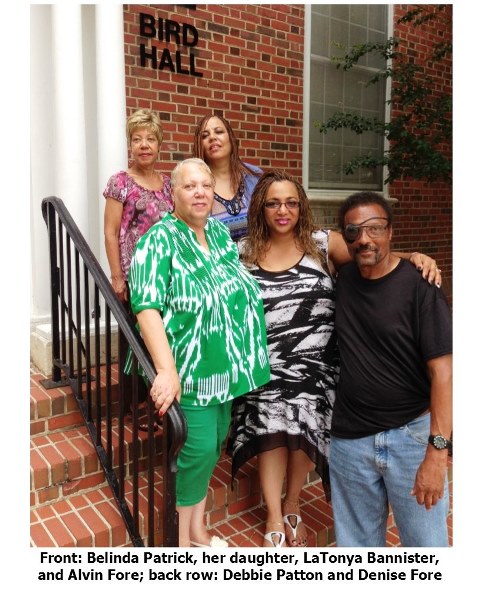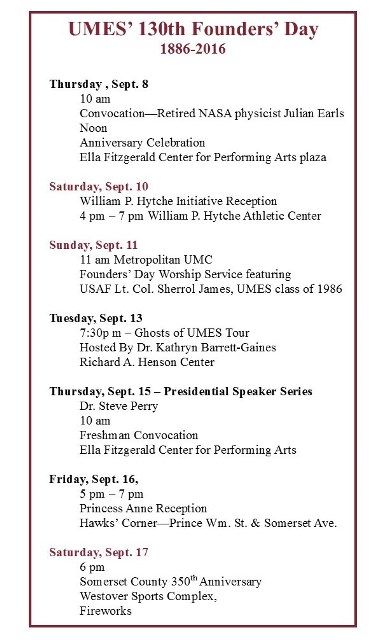
Wednesday, August 31, 2016
Descendants of UMES’ first educators explore their roots
PRINCESS ANNE, MD– (Sept. 1, 2016) – On a muggy weekend afternoon that defines Delmarva’s dog days of summer, five visitors gathered at the University of Maryland Eastern Shore looking for a palpable connection to their family history.
Just as Portia and Benjamin Bird must have experienced 130 years ago, a quintet of their descendants took in the sights and sounds of solitude that envelop the land-grant institution on a quiet Saturday. They came in search of stories about their two ancestors who founded the school for African Americans.
Four of the Birds’ great-grandchildren and a great-great-granddaughter made the pilgrimage to Princess Anne to see where the couple carved out a hardscrabble life as pioneering educators in post-Reconstruction America. It was the first time any of them had set foot on the campus.
Benjamin O. Bird was the founding principal of the Delaware Conference Academy that he and his wife, the former Portia E. Lovett, opened Sept. 13, 1886 as they welcomed the first nine students who dared to enroll. The couple is laid to rest on the campus.
“This fills that void of not knowing,” said Belinda Patrick of Culpepper, Va., the oldest great-grandchild. “It’s the final chapter. It brings what I’ve been working on some closure.”
Patrick’s grandfather was Lovett Burns Bird, born March 28, 1892 in Princess Anne some five and half years after Portia and Benjamin Bird accepted the Methodist Episcopal Church’s challenge to operate a prep school in rural eastern Maryland.
Because of its location in Somerset County’s seat of government, the school became known as Princess Anne Academy, which prepared some students for work on family farms and businesses. For others, it was a path to higher education.
Patrick decided after she retired she would busy herself doing research on her relatives, working to fill voids in her family’s story.
Joan Patricia Bird, Patrick’s mother and Lovett Bird’s only child, didn’t share much family history with her six children, including the four who visited the UMES campus.
“My mother never talked about her family at all,” said Debbie Patton of Las Vegas. “We just didn’t hear a lot about our family going back.”
“I don’t think my mother knew about the college,” added Denise Fore of San Francisco. “I think she would have told us.”
Denise and brother Alvin Fore of San Jose, Calif. accompanied their two older sisters and LaTonya Bannister, Patrick’s daughter, on a personalized campus tour conducted by historian Eric Jodlbauer of Princess Anne and three members of President Juliette B. Bell’s staff.
The visitors rode slowly in golf carts past UMES’ signature buildings visible to most motorists – the Student Services Center, the Fitzgerald Center for the Performing Arts, the William P. Hytche Athletic Center and the new Engineering & Aviation Science Complex.
UMES’ main campus is spread across some 745 acres, a far cry from the original 16 acres and a long-gone manor house that served as the academy’s first building.

The tour guides shared stories and anecdotes about UMES’ history, including a stop where Jodlbauer showed where the Birds lived and taught in the dwelling known as Olney. He also shared what he learned doing extensive research of church archives about how Princess Anne was chosen as the location for a satellite campus of then-private Morgan College in Baltimore.
“I never really had any interest in family history,” said Bannister, the great-great-granddaughter. “Now, I’m like … ‘Wow.’ I’ve come full circle. This woke me up.”
The Bird descendants posed for a photo in front of Bird Hall, originally a mechanical arts classroom building erected near the end of the Great Depression.
Next door, they stepped inside the lobby of J.T.Williams Hall, where posters featuring photos and narratives compiled by Jodlbauer reinforced the travelogue delivered during the outing.
The family finished its visit with a stop at the small campus cemetery where the Birds are buried. At first, they stood outside the wrought iron-style fence, respectfully capturing images of the gravestones on their phones and hand-held tablets.
When a vase of red roses and white carnations appeared, they hesitantly stepped through the gate to pay their respects.
Tears came to everyone’s eyes.
The emotional moment was more than a year in the making after Denise Fore insisted her siblings commit to gathering in Princess Anne to visit the place where Belinda Patrick had slowly been stitching together Internet nuggets.
“I needed to come and stand on the land of my forefathers,” Denise Fore said. “I’m so glad I did.”
Alvin Fore, who still answers to his childhood nickname “Ikey,” was a man of few words throughout much of the tour.
Afterward, he conceded the experience “meant a lot. I knew what they were doing, but I wasn’t that interested. I’m more interested – now that I came.”
Patrick’s goal is to publish her findings for succeeding generations of Birds scattered about the country.
“This a wonderful story that needs to be told,” she said.
UMES Office of Public Relations, (410) 651-6669

